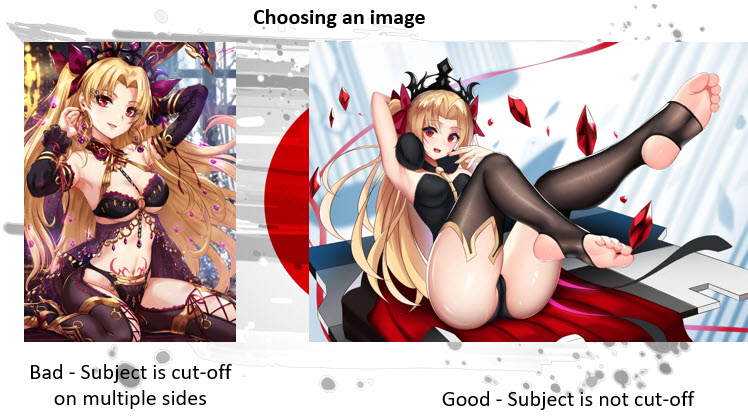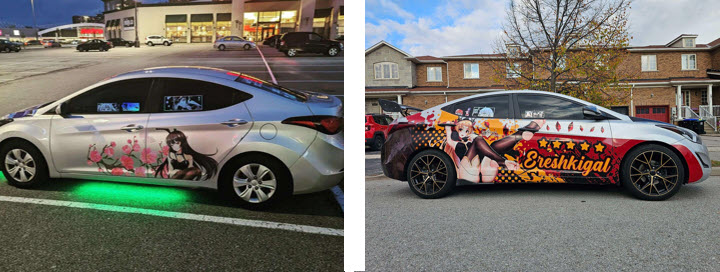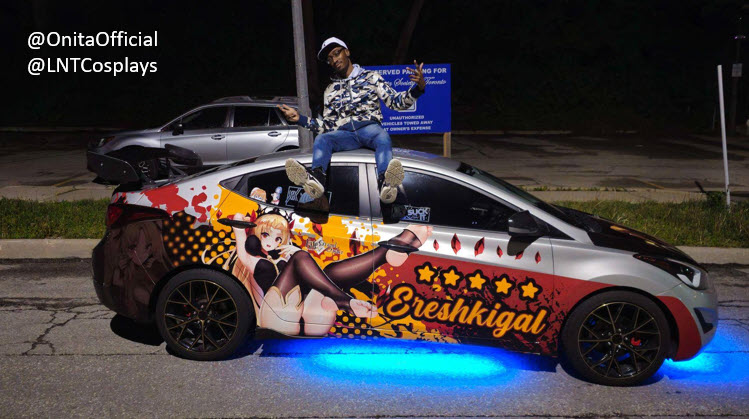Itasha: building and wrapping your car (Part 2)
- the DREAM
- Aug 23
- 8 min read
Updated: Oct 7
Covers the practical side of waifu wrapping your ride
As with all things Japanese, the cultural currents blow their influence overseas. And while this is an article focused on itasha, any good car lover can strip away the anime and look at this as a guide to wrapping their ride

Last time, we dove headlong into the chaotic, colorful history of itasha – Japan’s loudest, proudest, and most eyebrow-raising contribution to automotive self-expression. We covered everything from the humble early stickers to full wraps, Comiket’s role in the scene, and the fan-powered phenomenon that is Good Smile Racing.
Corporate Japan has also done this officially with Gundam and the Toyota Auris. So ..... ¯\_(ツ)_/¯
But now, it’s time to turn the focus on you. Yes, you, the wide-eyed Canadian (or American cousin) looking at your driveway and thinking: ‘What if my Honda Civic had more fan service across the hood?’ In this sequel, we’ll start with the fun part: choosing your waifu (or husbando), deciding where they’ll live on your ride, and learning the secrets to pro-level placement from seasoned wrappers and designers. Then we’ll slide into the pit of despair—aka the Top 5 Mistakes New Itasha Owners Make—where you’ll see why rushing in without planning, skimping on materials, or ignoring legal limits can cost you big. And finally we'll show you where you can find your people.
The Vanilla Wrap
Before you jump straight into putting Hatsune Miku in a Moutie Uniform on your trunk, let’s talk about the basics: wrapping a car in a single, solid color.
Vinyl wraps have become a go-to alternative to repainting, offering durability, reversibility, and sometimes even lower cost. In Canada, a professional single-color wrap typically runs between $2,000 and $4,000 CAD depending on vehicle size and complexity (Carscoops). DIY kits can drop that cost significantly, but come with a high skill curve. You’ll need a clean, dust-free environment, a heat gun, squeegee, and an infinite well of patience. One misplaced air bubble, and you’ll see it every day until you can’t stand it anymore.
Enter the Itasha
Once you’ve mastered the vanilla wrap (or skipped straight to hiring a pro), you can venture into the world of full custom graphics. This is where things get spicy – and pricy. A full anime-themed wrap, depending on design complexity and print quality, can range from $3,000 to $6,000 CAD, with premium materials and finishes pushing it higher (Wrapfolio.com). Custom printing requires high-resolution artwork, so either commission your favorite artist (and ensure you have rights to use the work) or find designs in the public domain.
Judging a book by it's cover (and with itasha, it's A LOT OF COVER)
So, you’ve decided to join the colorful cult of itasha: anime-clad cars that turn parking lots into rolling Comic-Cons.
Good call.
But before you slap Uma Musume across your hood like a sticker from a gacha machine, let’s slow down and talk strategy. Because while the right wrap can make your car the star of a convention, the wrong choices can leave you looking like the guy who put a 200 dpi screencap from Crunchyroll on his doors and wondered why it pixelated worse than a PS1 cutscene.
It’s tempting to think of itasha costs as nothing more than vinyl and printer ink, but the truth is uglier (and more expensive). A showstopper itasha isn’t just about the skin—it’s about the body underneath. Wheels, suspension, body kits, and even headlights all add to the final look, and sometimes they cost more than the wrap itself. A $2,500 vinyl job slapped on stock wheels and sagging suspension is like wearing Gucci with Crocs—people notice, and not in the way you want. The chart makes it clear: the exterior mods (tires, kits, lighting) often rank just as high in priority as the vinyl, because they frame the artwork and elevate it from “slapped on decal” to “rolling statement piece.” So here’s the damage breakdown: a rough price guide where the top priorities (highlighted in orange) will eat your wallet first.

Exterior is priority. Interior is secondary. In other words: your waifu might be the star, but the stage she’s standing on matters too. The wrap draws the eye, but it’s the stance, wheels, and supporting mods that keep jaws on the floor. If you’re budgeting for an itasha, treat the vinyl as the cover charge—what you do with the body determines if people stick around for the whole show.
At the end of the day, itasha are all about the look—nobody’s peeling back vinyl to admire your torque curve.
Mind the Modesty (or Don’t)
While Canada doesn’t have explicit nationwide laws against risqué vehicle wraps, provincial and municipal authorities can intervene under obscenity or indecency regulations. The rules are murky and often subjective – just like the recent controversies over rejected ‘offensive’ license plates in Ontario, where phrases deemed sexual, racist, or otherwise in bad taste were pulled from circulation (CBC). It’s rare, but there have been cases where explicit wraps have been challenged or removed under public decency bylaws. If you plan to go full NSFW, be prepared for attention – and not always the good kind.
Design It Right—Then Don’t Screw It Up
So you’ve picked your waifu, locked in a killer pose, and you’re ready to flex your fandom across every glistening inch of body panel. Hold up—let’s talk strategy before we get sloppy.
Rule #1: build your design on a real car template, not in your head.
Use the actual vehicle model outlines (check Pro Vehicle Outlines or templates for your car year) so you know exactly where seams, mirror hinges, sunroof tracks, and wheel arches live. You don’t want Saitama’s bald dome sliced in half by a door jamb because you thought symmetry looked “cool.” Reliable wrap professionals stress this for a reason—it’s your digital canvas and your install blueprint. This is also a great time to call on the pros in the art community and wrap shops. Dropping $300 on a well though out design now saves thousands on reprinting and rewrapping.
Rule #2: put major faces on big, flat panels like doors, quarters, and hoods.
The last thing you need is your waifu’s eyes warped into a crease when the door flexes. Itasha-specific design guides are brutally clear—reserve complex art for flat terrain and assign curves or tight shapes (like bumpers) for backgrounds or logos (10kwraps).
Rule #3: keep a cohesive theme with good scale.
Good images should not cut off key features of the character. But also, consider the size of the car. Small hatchbacks can’t handle multicharacter chaos—pick one icon or a harmonious palette. On longer cars or Vans (Supra stretch vans, anyone?), panoramic scenes thrive. Reddit veterans often say, “It’s not how many characters you have—it’s how hard your wrap hits.”
Rule #4: mind your resolution and color mode.
Wrap shops typically demand ~150 dpi at full size (or 300 dpi if you’re scaling down)—anything blurry looks like trash in person. Use CMYK, add generous bleed, and favor vectors for logos. Test-proof a panel before you bleed money on the full roll.
(https://www.1stimpressions.com/vehicle-wrap-artwork-guidelines/ • https://creatiwise.com/tips-for-creating-a-print-ready-file-for-vehicle-wraps/)
Rule #5: laminate and don’t block critical safety elements.
Automotive wraps get UV, salt, and pressure washes. Without an overlaminate, your art will fade, peel, and crack. Avoid covering lights, license plates, or driver sightlines. Use perforated film on glass if needed—and check local tint laws.
(https://graphics.averydennison.com/content/dam/averydennison/graphics/ap/en/Instructional-Bulletins/ib-4.06-processing-tips-for-laminating-films.pdf)
(https://multimedia.3m.com/mws/media/2419563O/application-vehicles-ra-pdf.pdf)
DIY: The Harsh Truth and the 'Do Nots'
Design done right makes people say, “Damn, that’s clean.” Now, let’s talk what will make them laugh behind your back.
Yes, you can wrap your car yourself.
No, it’s not as easy as YouTube makes it look.
Vinyl application requires a flawless prep job – every speck of dust, every trace of wax, every ding in your paint will telegraph through the wrap. Large, complex designs (like character art) also need precise panel alignment, which is a two-to-three-person job. If you’re going for a partial wrap (doors, hood, or roof only), DIY might be realistic. For a full wrap, professional installation will save you time, heartbreak, and potentially your marriage.

Rookie Mistakes That Turn Dreams into Dumpster Fires
Mistake #1: Low-resolution art or IP theft.
Print that tiny PNG and it’ll pixelate so bad that your car will look like it ran through a blender. Plus, if you’re using someone else's art without permission—shops will shut you down faster than a copyright notice from a disapproving studio. Always use high-res files or commissioned art you own (autotize, Yeswrap)
Mistake #2: Cheapo vinyl.
Calendered films shrink and wrinkle; only premium cast films like 3M 2080 or Avery SW900 conform properly. Skimping here is a shortcut to lift and curl—overnight (Metrostyling).
Mistake #3: Skipping prep, lamination, and post-heat.
Wax residue, dust specs, and raw edges will throttle your wrap’s lifespan. If you don’t post-heat your stretches to “unlock” memory, your corners will betray you (and peel). Do the deep clean. Do the lamination. Do the heat (averydenison.com).
Mistake #4: Terrible alignment/cropping.
You’ll hear it echo on forums: “Please, not across the door seam!” It’s embarrassing, avoidable, and screams amateur. Invest the time to plan and align properly, or get help during install day (10k Wraps).
Mistake #5: Ignoring hotspots and edge seals.
Tight bumps, ledges, and corners are wrap killers if not sealed or tucked properly. Manufacturers include bulletins for a reason—do not skip them. You can’t fix what you can’t reach… especially when your spoiler starts creeping off at highway speed. (3m)
From Garage to Convention Floor Finding Your People: Itasha Clubs in North America
Building your own itasha is part art project, part mechanical challenge, and part social experiment. Done right, it’s a showstopper – the kind of thing that will get you photographed, followed, and possibly invited to events you didn’t even know existed. But it’s also a commitment: money, time, and a willingness to drive a car that will never blend in again. So whether you start small with a set of character decals or go all-in with a full wrap, remember – it’s your ride, your canvas, and your place in the growing Canadian and North American itasha scene.
“Do it alone—you're weird. Do it with friends—you’re in a club!”
🇺🇸 Itasha Wonderland (Festival)
Hosted annually at San Japan in San Antonio, Texas, Itasha Wonderland is the first large-scale itasha-specific car show in the U.S., featuring over 70 anime-wrapped rides . The event’s crossover appeal pulls in both hardcore JDM builders and casual anime fans, creating a unique space where you can see a Liberty Walk GT-R parked next to a Sailor Moon Civic.
🇨🇦 ONITA – Otaku North Itasha Alliance

Canada’s undisputed itasha heavyweight, ONITA has made Toronto its home base, staging massive convention-adjacent meets at Anime North and regional cruises across Ontario. Their Instagram (https://www.instagram.com/onitaofficial/) is a steady drip of new builds, from Naruto sedans to Monster Musume Lancers all the way to Bentleys with Dragonballs, and they regularly collaborate with wrap shops to push design boundaries. Beyond showing off cars, ONITA’s value is in mentorship—helping newcomers avoid rookie mistakes like misaligned seams or accidentally slicing through paint during a DIY attempt. Look them up on instagram @ontiaofficial !
🇺🇸 Weeb Stop & Senpai Squad
In Houston, Weeb Stop and Senpai Squad have merged nightlife culture with itasha, producing wraps that double as merch campaigns. Their builds have been profiled in the Houston Chronicle for pushing both quality and thematic boldness. Think widebody kits, LED underglow, and character art that doesn’t just sit on the panel—it interacts with the car’s lines.
Check out the 'thematic boldness' on this civic!
Senpai Squad's first Canada sponsored vehicle
Type-R: @nerothetyper (IG) Team Page: @teamsenpaisquad (IG)
The Final Lap
Building your own itasha is part craftsmanship, part community, and part “how much judgment from strangers can you handle?” From basic solid-color wraps to full-character liveries, the process is both more accessible—and more technically demanding—than most newcomers expect. But with fan-run clubs, pro wrap shops, and an ever-growing North American scene, there’s never been a better time to roll into a meet with your favorite character riding shotgun… in vinyl form.
If you had the money and the motivation, what would your ride + wrap combo be? Comment below!































Do not forget us rednecks, and our camo wraps. Any pics/ info/ advice on wrapping a Kei truck in camo?